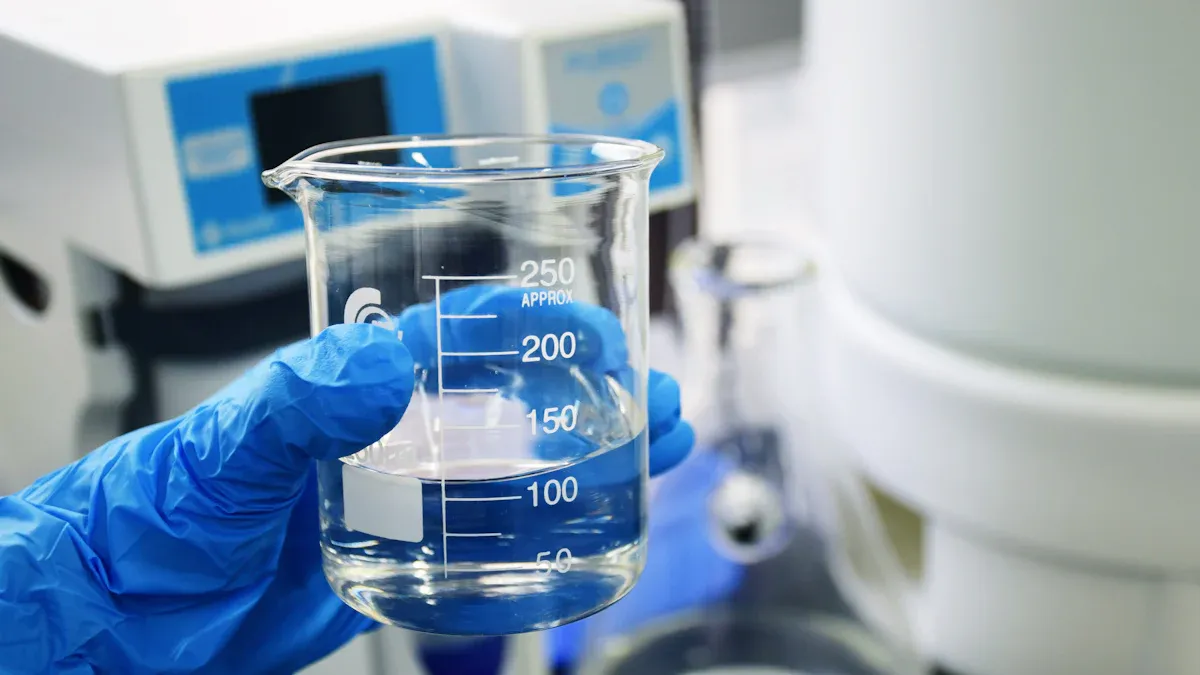
You might ask what metal removal activated carbon is. This type of carbon helps clean water by catching harmful metals. Many people use it to treat wastewater and make water safer. Heavy metals like lead, mercury, cadmium, arsenic, and chromium can pollute water. These metals can cause bad health problems. They can also hurt the environment.
Heavy Metal | Health Risks | Environmental Impacts | |
|---|---|---|---|
Lead | 0.01 | Trouble thinking, high blood pressure, kidney problems | Bad for plants and fish growth |
Mercury | 0.001 | Nerve damage, kidney problems | Hurts how animals act and have babies |
Cadmium | 0.05 | Kidney problems, can cause cancer | Makes soil and water dirty, hurts water animals |
Arsenic | 0.01 | Skin problems, higher chance of cancer | Stops plants from growing well and lowers farm crops |
Chromium | 0.003 | Lung swelling, skin sores | Can cause health problems like insulin resistance |
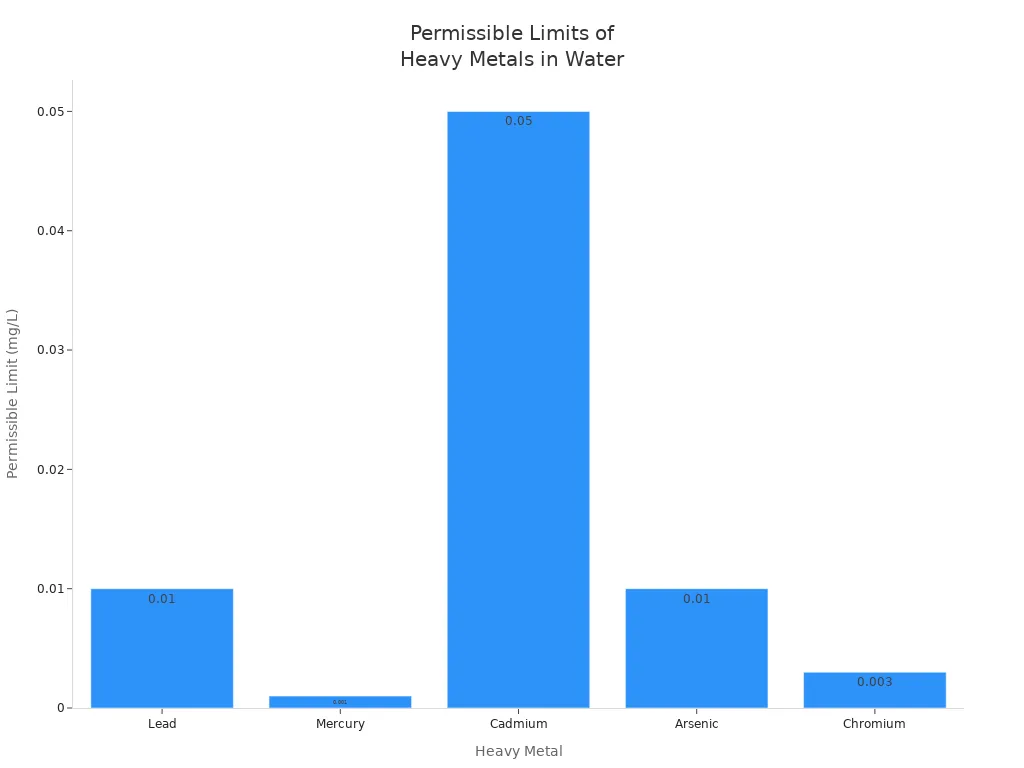
Using the right solution keeps you healthy and helps the Earth.
主要收获
Metal removal activated carbon helps clean water. It traps harmful heavy metals like lead and mercury.
Using activated carbon made from biomass is good for the environment. It works well to remove many metals from water.
There are different types of activated carbon. Granular and powdered forms work best for certain uses and metal types.
You should check water quality often. Also, watch pH levels to make sure the activated carbon system works well.
Pick the right activated carbon for the metal you want to remove. This helps you get the best results.
Activated carbon can be used more than once. This makes it a cheaper way to treat water.
Setting up the system well and treating water first helps activated carbon work better.
Do not reuse old filters or forget to check pH levels. This keeps water safe.
What Is Metal Removal Activated Carbon
Metal removal activated carbon helps clean water by catching dangerous metals. People use it to make water safe for drinking, farming, and factories. This special carbon comes from things like coconut shells, coal, wood, or waste. Many companies pick biomass-derived activated carbon because it is better for nature and works well for heavy metal removal.
主要功能
There are some important things about metal removal activated carbon:
High Surface Area: The carbon has lots of tiny holes. These holes make a big surface area. A bigger surface area lets it catch more metals.
Porous Structure: The pores help trap metals like lead, nickel, and cadmium.
Strong Adsorption: The carbon grabs onto metals tightly. This makes it good for heavy metal removal.
Eco-Friendly Options: Many people use biomass-derived activated carbon. It comes from coconut shells, nut shells, or wood waste. This makes it a green choice for cleaning up pollution.
Customizable: You can get different shapes and sizes. Some types work better for certain metals or water systems.
Here is a table that shows how much metal different activated carbons can catch:
Type of Activated Carbon | Heavy Metal Ion | Adsorption Capacity (mg·g−1) |
|---|---|---|
Acid Activated Carbon | Ni(II) | 19.6 |
Acid Activated Carbon | Pb(II) | 74.6 |
Commercial Activated Carbon | Cr(VI) | 71 |
Prepared Activated Carbon | Cr(VI) | 46.30 |
Acid Activated Carbon | Divalent Cations | High affinity in low concentration |
Commercial Activated Carbon | Divalent Cations | Poor affinity in low concentration |
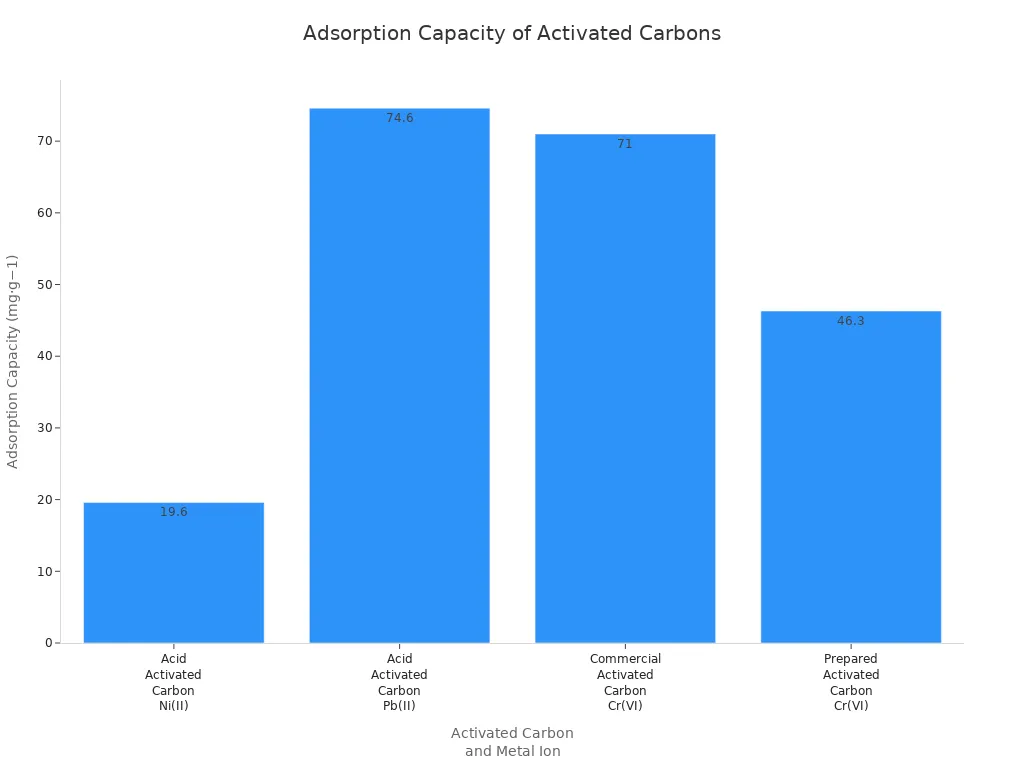
Tip: Biomass-derived activated carbon often catches many metals. You can use it for small or big water treatment systems.
类型
There are many types of activated carbon for heavy metal removal. Each type has its own good points. Many people now use biomass-derived activated carbon because it is renewable and works well.
Granular Activated Carbon (GAC): You find this type in water filters. It has medium or big grains. It works for homes and factories.
Powdered Activated Carbon: This type has tiny particles. You can mix it into water for fast treatment.
Pelletized Activated Carbon: These are small, solid pellets. They are easy to use in columns.
Honeycomb Activated Carbon: This type has a special shape. It gives a big surface area and is easy to stack.
Coconut Shell Activated Carbon: Made from coconut shells, this is a popular biomass-derived activated carbon. It is strong and has a big surface area.
Nut Shell and Wood-Based Activated Carbon: These come from nut shells or wood waste. They are also biomass-derived activated carbon.
Coal-Based Activated Carbon: This type comes from coal. It is strong and works for many metals.
Physically Activated Carbon: Made by heating carbon-rich stuff in steam or air.
Chemically Activated Carbon: Made by treating materials with chemicals before heating.
Impregnated Activated Carbon: This type has extra chemicals to help catch certain metals.
Here is a table that compares the main types:
Type of Activated Carbon | Iodine Value (mg/g) | Mesh Size | Apparent Density (kg/m³) |
|---|---|---|---|
颗粒活性炭 (GAC) | 600-1200 | 1×4 to 40×70 | 400-700 |
粒状活性炭 | 500-1300 | 0.9-8mm | 450-600 |
粉末活性炭 | 500-1300 | 150-350 | 450-550 |
蜂窝活性炭 | 400-800 | 100×100×100mm | 350-450 |
椰壳活性炭 | 700-1200 | 不适用 | 320-550 |
果壳活性炭 | 700-1200 | 不适用 | 320-550 |
煤基活性炭 | 700-1200 | 不适用 | 300-650 |
木质活性炭 | 700-1200 | 不适用 | 320-550 |
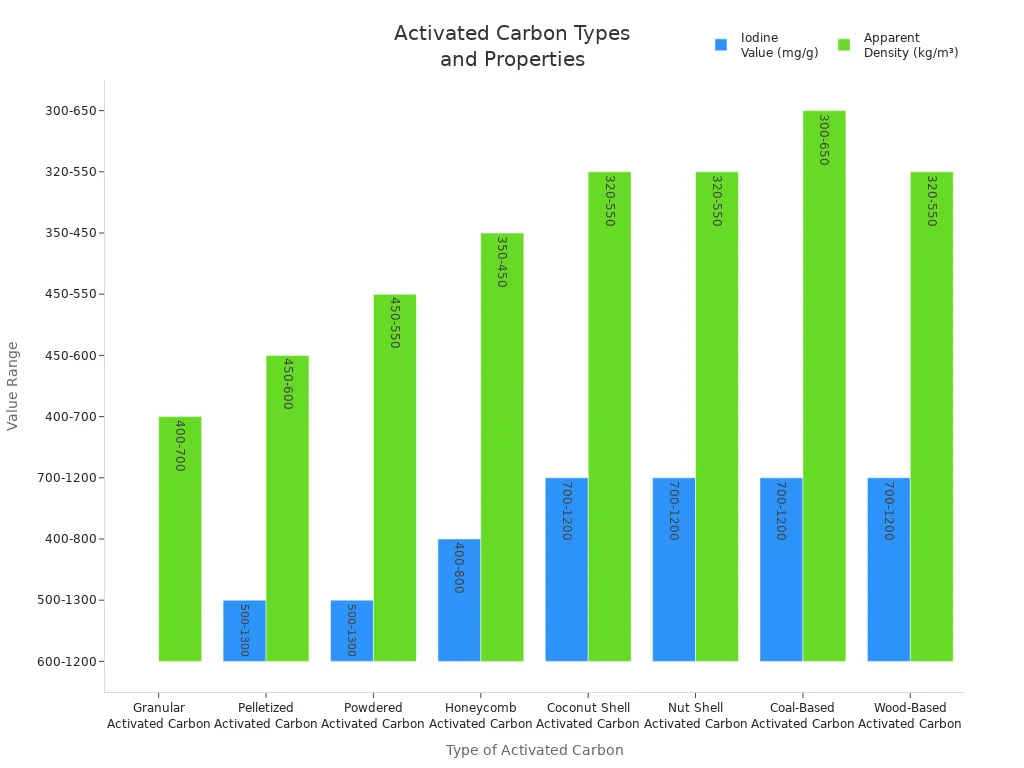
Note: Biomass-derived activated carbon, like coconut shell or wood-based carbon, often has a high iodine value. This means it can catch more metals.
Target Metals
You can use metal removal activated carbon to catch many harmful metals. Some of the most common ones are:
Lead (Pb)
Cadmium (Cd)
Nickel (Ni)
Copper (Cu)
Biomass-derived activated carbon works well for these metals. It can also help remove other metals like chromium and zinc. You can see how well activated carbon removes these metals in the table below:
Heavy Metal | Removal Efficiency at 80 °C (%) | Removal Efficiency at 60 min (%) |
|---|---|---|
Cadmium | 93.23 ± 0.035 | 99.235 ± 0.148 |
Copper | 96.71 ± 0.097 | 96.711 ± 0.083 |
Nickel | 92.01 ± 0.018 | 95.34 ± 0.015 |
Lead | 95.42 ± 0.067 | 97.750 ± 0.166 |
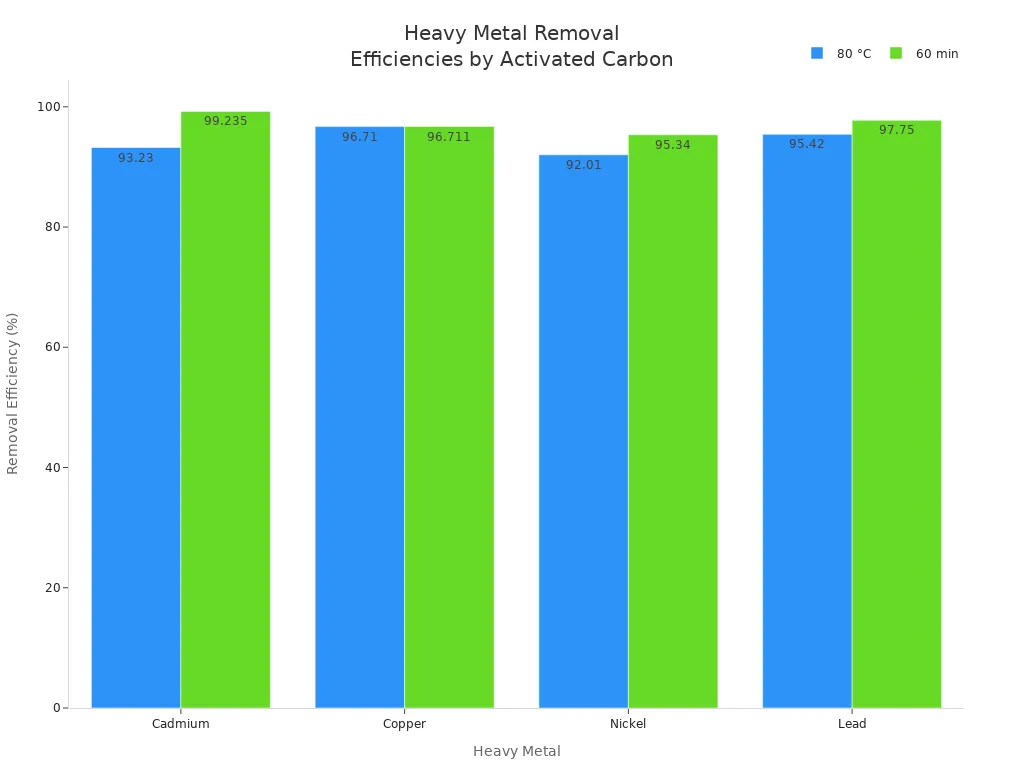
Biomass-derived activated carbon can reach high removal rates for many metals. You can use it for home or industrial water treatment.
Heavy metal removal with activated carbon works very well. Many people now pick biomass-derived activated carbon because it works great and is good for the planet. You help keep yourself and nature safe when you use these solutions.
Heavy Metals Removal: Why It Matters

Health Risks
Heavy metals in your water can make you very sick. Even a little bit can hurt your body. Some metals, like lead, mercury, and cadmium, cause problems right away and later in life.
Lead can make you tired and give you headaches. It can also hurt your stomach. Over time, it can damage your brain and kidneys. Kids who get lead may have trouble learning or thinking.
Mercury can hurt your brain and kidneys. You might forget things or have shaky hands. It can also change how you see and hear. Pregnant women must be careful because mercury can hurt their babies.
Cadmium can mess up how your body uses nutrients. It can also stress your cells and make you feel weak.
Drinking water with heavy metals is dangerous. Keeping your water clean helps keep your family safe.
环境影响
Heavy metals do not only hurt people. They also harm nature. When these metals get into rivers, lakes, or dirt, they build up in fish and plants. This is called bioaccumulation. Fish and animals that eat bad plants or other animals can get sick or die.
Heavy metals in water can poison fish and other water animals. This can mess up the whole ecosystem.
Dirty soil makes it hard for plants to grow. Crops may die, and the soil loses good nutrients.
Tiny living things in the soil also get hurt. They grow slower and cannot help plants as much.
You help stop pollution when you remove heavy metals. Clean water and soil mean healthier plants, animals, and people.
Regulations
Many countries have strict rules for heavy metals in water. These rules keep you and nature safe from pollution. Groups like the Environmental Protection Agency (EPA) in the United States set limits for metals like lead, mercury, and cadmium in drinking water.
Metal | EPA Limit (mg/L) |
|---|---|
Lead | 0.015 |
Mercury | 0.002 |
Cadmium | 0.005 |
If you run a water plant or handle wastewater, you must follow these rules. Meeting these standards helps stop pollution and keeps your community safe. Removing heavy metals is not just smart—it is the law in many places.
Following the rules and using the right methods keeps your water safe and your environment clean.
Adsorption of Heavy Metals: How It Works
You may wonder how biomass-derived activated carbon takes metals out of water. The answer is a process called adsorption of heavy metals. This lets the carbon grab and hold metal ions. It makes your water cleaner and safer.
机制
Adsorption of heavy metals happens in two main ways. These are physical adsorption and chemical adsorption. Both are important for how well biomass-derived activated carbon works.
Physical Adsorption
Physical adsorption uses the natural shape of the carbon. Biomass-derived activated carbon has lots of tiny pores. These pores act like traps for metal ions. When you use this carbon, metal ions stick to the surface. The pores fill up with these ions. First, one layer of metal ions forms. Later, more layers can build up. This creates a strong shield against pollution.
机制 | 说明 |
|---|---|
The size and shape of the pores decide how much metal the carbon can catch. Micropores do most of the work, while mesopores help metals move inside. | |
吸附过程 | The process starts with one layer of metal ions. More layers form later, making a thick shield. |
Functional Groups | Special groups on the carbon surface, like carboxyl groups, help grab metal ions by ion exchange and chelation. |
Tip: More pores and bigger surface area mean better adsorption of heavy metals.
Chemical Adsorption
Chemical adsorption goes further than physical adsorption. The surface of biomass-derived activated carbon has special chemical groups. These groups react with metal ions and form strong bonds. Carboxyl groups are very important. They can swap ions with metals or make tight chelation bonds. This makes the adsorption of heavy metals stronger and last longer.
When both physical and chemical adsorption work together, you get better results. This double action increases how much metal the carbon can catch. It makes it a great choice for cleaning wastewater and fighting pollution.
Factors Affecting Adsorption
Many things can change how well biomass-derived activated carbon works. You need to know these to get the best results.
pH and Chemistry
The pH of your water changes how metal ions and carbon surfaces interact. Each metal has its own best pH range for adsorption of heavy metals.
Heavy Metal | |
|---|---|
Lead (Pb2+) | 5.5 – 6 |
Cadmium (Cd2+) | 7 – 8 |
If the pH is too low or too high, adsorption drops. For example, lead sticks best to biomass-derived activated carbon at pH 5.5 to 6. Cadmium works better at pH 7 to 8. You should always check and adjust the pH for the best results.
表面积
The surface area of biomass-derived activated carbon is very important. A bigger surface area means more places for metal ions to stick. The porous structure helps too. Micropores catch metals, and mesopores let them move deeper inside.
Big surface area gives more room for adsorption.
Porous structure helps trap different metal ions.
Over time, you may need to clean your carbon to keep it working well.
Note: Always pick biomass-derived activated carbon with a high surface area for the best heavy metal removal.
Recent Research Findings
Scientists have tested many types of biomass-derived activated carbon and other materials. Some new materials, like tire-derived adsorbents and biochar, work very well. You can see how well these materials work in the tables below.
Material | Heavy Metal | |
|---|---|---|
Chemically activated carbon from tires | Cd (II) | 201 |
Chemically activated carbon from tires | Pb (II) | 196 |
Aircraft tire rubber ash | Cr (VI) | 92.24 |
Pineapple peel-based biochar | Cr (VI) | 41.67 |
Orange peel biomass | Cr (VI) | 100.4 |
Hemicellulose-derived activated carbon | Cr (VI) | 349.6 |
You can see that hemicellulose-derived activated carbon catches a lot of chromium. Tire-derived carbon also works well for cadmium and lead. These results show you have many choices for biomass-derived activated carbon with strong adsorption.
Did you know? Using waste like tires and fruit peels to make biomass-derived activated carbon helps cut pollution and boosts adsorption of heavy metals.
If you want to remove metals like lead, cadmium, nickel, chromium, zinc, or cobalt, check the adsorption capacity of your carbon. Some types work better for certain metals. For example, tire-derived carbon can catch up to 201 mg of cadmium per gram. Hemicellulose-derived carbon can catch up to 349.6 mg of chromium per gram.
When you use biomass-derived activated carbon with high adsorption, you get better heavy metal removal. You also help protect the environment. This makes adsorption technology a smart choice for anyone dealing with wastewater or pollution.
Metal Removal Activated Carbon Methods
If you want to use biomass-derived activated carbon for heavy metal removal, you have a few choices. Each method uses the adsorption of heavy metals in its own way. You should pick the method that works best for your needs. There are three main methods: batch process, column process, and fluidized bed.
Batch Process
The batch process treats a set amount of water at once. You put biomass-derived activated carbon into a tank with water that has metals. The carbon mixes with the water. The adsorption of heavy metals happens when metal ions stick to the carbon’s surface. You let the mixture sit for a while. Then, you filter out the carbon. This method is good for small jobs or testing new carbon types.
Steps in the batch process:
Put biomass-derived activated carbon in the water.
Stir or shake the mixture well.
Wait for the adsorption of heavy metals to happen.
Filter the carbon out of the water.
Check the water for any metals left.
Tip: You can use the batch process to test how well different biomass-derived activated carbon samples work.
Column Process
The column process is good for water that keeps flowing. You fill a column with biomass-derived activated carbon. Water moves through the column from top to bottom. The adsorption of heavy metals happens as water passes through the carbon. This method lets you treat lots of water without stopping. You can use it at home, in factories, or in city plants.
Benefits of the column process:
You get steady metal removal.
You can check the adsorption capacity over time.
You can change or clean the carbon when needed.
A column setup helps you know when the biomass-derived activated carbon needs to be replaced.
Fluidized Bed
In the fluidized bed method, water flows up through a layer of biomass-derived activated carbon in a tank. The water lifts the carbon particles so they float and move around. This makes the water and carbon mix better. The adsorption of heavy metals happens faster because more carbon surface touches the water. You can use this method for quick treatment and high adsorption capacity.
Why choose a fluidized bed?
You get better mixing and faster adsorption of heavy metals.
You can handle changes in water flow or metal levels.
You can use different sizes of biomass-derived activated carbon for better results.
Note: The fluidized bed method is best when you need fast heavy metal removal and high adsorption capacity.
Each method uses the adsorption of heavy metals in a special way. Think about your water needs, the metals you want to remove, and the adsorption capacity of your biomass-derived activated carbon before you pick a method.
Method Comparison
You might wonder which metal removal method works best for your needs. Each method—batch, column, and fluidized bed—has its own strengths and challenges. Let’s look at how they compare so you can make a smart choice.
Batch Process
You use the batch process when you want to treat a set amount of water at one time. This method gives you control over how long the carbon stays in contact with the water. You can test different conditions and see what works best. Batch processes often need more time for the carbon to catch all the metals. You might wait anywhere from 6 minutes to 3 hours, depending on the water and the metals you want to remove.
Column Process
You use the column process for water that flows all the time. This method works well for homes, factories, or city water plants. Water moves through a column filled with activated carbon. The carbon grabs the metals as the water passes through. You get steady results and can treat large amounts of water. The contact time for metals like lead and chromium can range from about 2 to 3 hours before the carbon needs to be replaced or cleaned.
Fluidized Bed
You use the fluidized bed method when you need fast treatment. Water flows up through the carbon, making the particles float and mix. This gives you better contact between water and carbon. You can treat water quickly and handle changes in flow or metal levels. Scientists do not always report exact contact times for this method, but it often works faster than the other two.
Here is a table that shows typical contact times for each process:
Process Type | Contact Time (min) | 说明 |
|---|---|---|
Batch | 6, 30, 60, 90, 120, 150, 180 | Time depends on your setup and goals |
Column | 128 (Pb), 177 (Cr) | Breakthrough times for other metals fall in between |
Fluidized Bed | 不适用 | Usually faster, but no set time |
小贴士 If you want to test new carbon or treat small batches, try the batch process. For steady, ongoing treatment, use a column. If you need speed and flexibility, the fluidized bed might be your best choice.
Summary List:
Batch: Best for small jobs and testing. Gives you control but takes more time.
Column: Good for large, steady flows. Works well for homes and factories.
Fluidized Bed: Fast and flexible. Handles changes in water flow or metal levels.
You should think about your water needs, how much water you want to treat, and how quickly you need results. Picking the right method helps you get clean water and protect your health.
Benefits of Metal Removal Activated Carbon
Efficiency
You want something that works fast and takes out lots of metals. Metal removal activated carbon is very good at this job. It can remove almost all heavy metals from water. This makes your water much safer to use. You can drink it, water plants, or use it in factories.
Let’s look at how it does compared to other ways:
Technology | |
|---|---|
活性炭 | ~99% |
Reverse Osmosis | >98.75% |
Ion Exchange | ~90% |
Activated carbon works as well or better than other methods. It removes nearly all metals like lead, cadmium, and chromium. You do not have to worry about metals left in your water. This high efficiency means you spend less time treating water.
Tip: High efficiency means you save time and worry less about health problems.
Cost
You might think this strong solution costs a lot. But metal removal activated carbon is often cheaper than other choices. You can buy it as powder, pellets, or granules. This lets you pick what fits your budget.
Here are some reasons you save money:
You can use it in simple systems that do not need fancy machines.
You can buy a lot for big jobs or just a little for home.
You do not spend much on upkeep because it lasts long.
Many people pick this method because it works well and does not cost too much.
可重用性
You want something that does not make a lot of waste. Metal removal activated carbon can be used more than once. After each use, you can clean it so it works again.
Here is a table showing how well different types work after several uses:
Type of Activated Carbon | Cycle 2 Removal (%) | Cycle 3 Removal (%) | Cycle 4 Removal (%) | |
|---|---|---|---|---|
CMA | >90 | Gradual drop | 不适用 | 不适用 |
CMAT | ~90 | ~90 | ~90 | ~90 |
A | >90 | 不适用 | 不适用 | 72 |
Some types keep removing over 90% of metals for up to four times. You do not have to buy new carbon every time. This saves you money and helps the planet by making less waste.
Note: Always check how well your carbon works after each use. This helps you know when to clean or replace it.
Versatility
You can use metal removal activated carbon in lots of ways. It is a flexible tool for cleaning water. You can use it at home, in a business, or in a factory. There is a solution for every need.
Activated carbon works well almost anywhere metals are a problem. You can use it in homes, schools, factories, or city water plants. This shows how useful and adaptable it is.
Application Area | Effectiveness Range | Key Factors Influencing Efficiency |
|---|---|---|
Industrial Wastewater Treatment | 75% – 96% | Dosage, solution pH, surface properties, contaminant concentrations |
Heavy Metal Removal | 高 | Modified activated carbon shows promising adsorption kinetics |
Research and Development | Ongoing | Need for cost-effective synthesis and real-world efficacy studies |
In factories, it can remove 75% to 96% of metals. The results depend on how much carbon you use and the water’s pH. The type of metal also matters. Modified activated carbon can remove even more metals. Scientists keep working to make it better and cheaper.
Tip: You can change the type or amount of activated carbon. This helps you get the best results for your water.
You do not need fancy machines to use activated carbon. You can put it in a simple filter or a big water plant. Many people use it in home filters to catch metals like lead. Factories use bigger systems for lots of water. City plants use it to meet safety rules.
You can also use activated carbon with other treatments. For example, you can mix it with sand filters or reverse osmosis. This makes your water even cleaner. You can use it for one metal or many at once.
Here are some ways to use metal removal activated carbon:
Clean water in factories before it goes to rivers
Make drinking water safe at home
Help schools and hospitals give safe water
Support research to find new ways to remove metals
Note: You can always find a way to use activated carbon, no matter how big or small your water problem is.
Metal removal activated carbon works for many needs. You can trust it in many places and for many metals. It is a smart choice for anyone who wants clean water.
Tips for Beginners
Choosing Carbon
You need to pick the best carbon for your water. Not every activated carbon works the same way. First, check which metal you want to remove. Some carbons are better for lead. Others work best for mercury or cadmium. Small carbon pieces catch more lead. Sulfur-impregnated carbons help with mercury. For arsenic, use modified carbons and check the pH. If you want to remove chromium, keep the water acidic. For copper and zinc, fast reactions help a lot.
Here is a table to help you choose:
Heavy Metal | Optimal pH Range | Removal Efficiency | Key Considerations |
|---|---|---|---|
Lead (Pb) | 5-7 | >90% | Finer particle size enhances effectiveness |
Mercury (Hg) | 不适用 | >95% | Use of sulfur-impregnated carbons is crucial |
Cadmium (Cd) | Neutral to slightly alkaline | Up to 85% | Temperature sensitivity is important |
Chromium (Cr) | Acidic for Cr(VI) | 80-90% | Competing ions affect efficiency |
Arsenic (As) | 不适用 | 不适用 | Modified carbons and pH monitoring are essential |
Copper (Cu) | Broad pH range | 85-95% | Quick equilibrium is beneficial |
Zinc (Zn) | Neutral | 75-85% | Competing metals can affect removal |
Nickel (Ni) | 不适用 | 70-80% | Temperature control is essential |
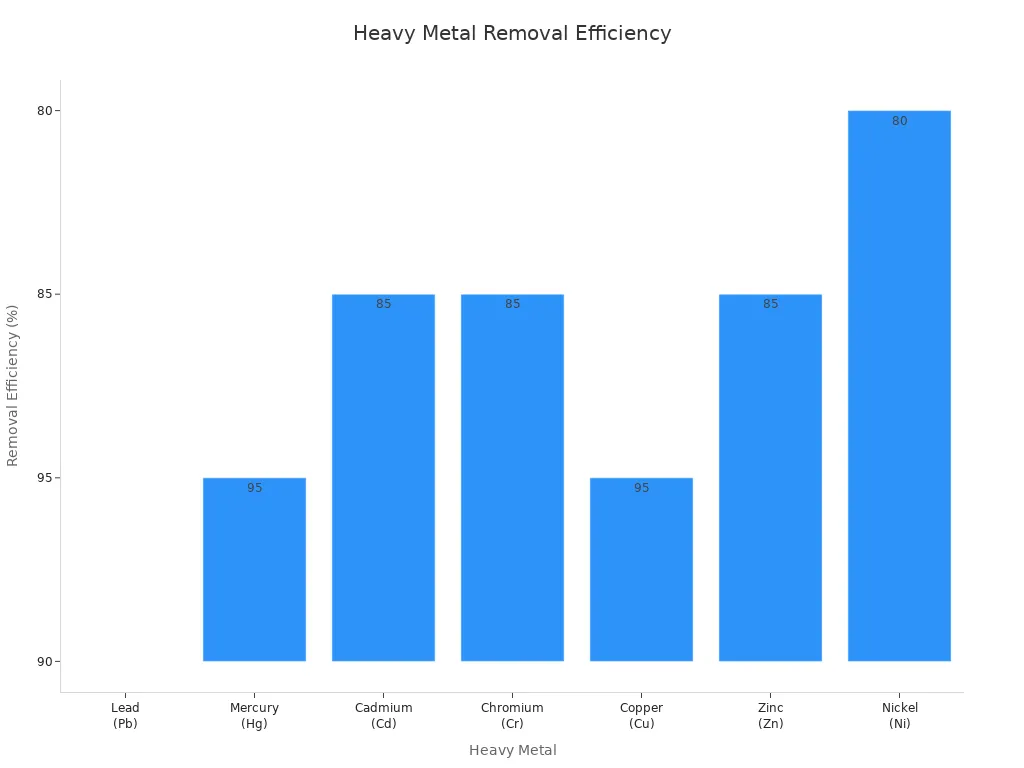
Tip: Always use the right carbon for your metals. Check pH and temperature for the best results.
System Setup
You need a good setup for your carbon system. Make sure your water is clean before it touches the carbon. Pretreat the water to get rid of dirt and big pieces. This keeps the carbon working well. Use enough carbon for your water size. More carbon helps, but do not waste it.
Follow these steps for a strong system:
Pick the right pore size and surface for your metals.
Use enough carbon for your water flow.
Set up the system so water moves evenly through the carbon.
Note: A good setup makes your carbon last longer and work better.
Monitoring
You want your system to work well all the time. Check it often to find problems early. Watch the metal levels in your water. If they go up, your carbon may be full. Test the pH often because it matters for metal removal. Make sure the water going in is right for your system.
Here are some ways to check your system:
Test metal levels in the water often.
Check pH to keep it in the best range.
Look for signs that the carbon is full.
Change or clean the carbon when it stops working well.
Track water quality before and after treatment.
Tip: Checking your system keeps your water safe and helps your carbon work longer.
Common Mistakes
When you start using activated carbon for metal removal, you might make some common mistakes. Knowing these mistakes helps you get better results and keeps your water safe.
Reusing Old Filters
You may think you can wash and reuse activated carbon filters. This does not work well. Washing does not remove all the trapped metals. Old filters lose their power and let metals pass through. Always use fresh filters when the old ones stop working.Trying to Recharge Filters with Sunlight
Some people believe that putting filters in sunlight makes them work again. Sunlight does not recharge activated carbon. In fact, leaving filters in the sun can cause mold to grow. Mold makes your water unsafe. Replace your filters instead of trying to recharge them.Folding or Bending Filters
You might want to fold filters to fit them into your system. Folding or bending damages the filter. Damaged filters cannot catch metals well. Always keep your filters flat and handle them with care.Not Checking Water Quality
You may forget to test your water before and after using activated carbon. If you do not check, you cannot know if the filter works. Always test your water for metals. This helps you know when to change the filter.Using the Wrong Type of Carbon
Not all activated carbon works for every metal. Using the wrong type means you do not remove the metals you want. Check which metals you need to remove and pick the right carbon for the job.Ignoring pH Levels
The pH of your water affects how well activated carbon works. If the pH is too high or too low, the filter may not catch metals. Always test and adjust the pH to the best range for your target metal.Overloading the System
Putting too much water through the filter at once can lower its performance. The carbon needs time to catch metals. Use the right flow rate for your system.
小贴士 Handle your filters gently and replace them when needed. Test your water often to make sure your system works well.
Avoiding these mistakes helps you get the best results from your activated carbon system. You keep your water clean and safe for everyone.
应用
Industrial Use
Factories use biomass-derived activated carbon in many ways. They need to clean water before letting it go outside. You see this carbon in chemical plants and medicine factories. Food and drink factories use it too. Places that handle radioactive gases also use it. Each place has its own needs for catching heavy metals and other bad stuff.
工业部门 | |
|---|---|
Chemical Processing | Catches dangerous chemicals so they do not pollute nature. |
Pharmaceutical Processing | Removes toxins to keep products pure and clean. |
餐饮 | Takes out chemicals, smells, and germs to keep food safe. |
Radioactive Gas Removal | Catches radioactive iodine to protect workers and the environment. |
When you use this carbon, you help stop pollution. It can catch lots of metals and toxins. Many factories pick this carbon because it works well. It helps remove heavy metals. It also keeps workers and nature safe from harm.
家庭使用
You can use this carbon at home to make water safer. Many home filters have biomass-derived activated carbon inside. The carbon traps metals and other bad things as water flows through. Its big surface and tiny holes help catch more stuff.
Here is how it works at home:
机制 | 说明 |
|---|---|
Adsorption | Pollutants stick to the carbon, trapping heavy metals. |
Ion-Exchange | Heavy metals swap places with safer ions, lowering pollution. |
表面积 | The big surface helps trap more bad things. |
Porous Structure | Tiny holes let water touch more carbon, making filtering better. |
Chemical Activation | Chemicals like phosphoric acid make more holes, helping the filter catch more metals. |
Filters with high adsorption work better. You can take out lead, cadmium, and other metals from your water. This keeps your family safe from health problems. It also helps the planet by making less dirty water. Using this carbon is good for nature because it comes from plants.
Municipal Use
Cities use this carbon in big water plants. These plants clean water for many people. The carbon helps remove heavy metals to meet safety rules.
City plants have some problems:
It does not always catch all inorganic pollutants
Other stuff in water can block the carbon
The carbon does not last forever
You can fix these problems by:
Mixing carbon with other cleaning methods
Using carbon made from sludge to save money and remove metals like chromium and cadmium
If the carbon gets blocked, it cannot catch as much metal. You need to change or clean the carbon to keep it working. Many cities now use more than one method to clean water better.
Tip: Using this carbon in city water plants helps keep water safe for everyone.
Case Studies
You can learn a lot from real-life stories. These examples show how biomass-derived activated carbon works in many places. You see how adsorption capacity changes with each project. Looking at these cases helps you understand why people trust biomass-derived activated carbon for heavy metal removal.
One project used tire-derived biomass-derived activated carbon to clean water. The water had lead, copper, and zinc. The team made pyrolysis char from old tires. This char had a high adsorption capacity for each metal. You can see the results in the table below:
Heavy Metal | Method of Removal | Source |
|---|---|---|
Lead | ||
Copper | Pyrolysis char as adsorbent | |
Zinc | Pyrolysis char as adsorbent | |
Arsenic | Modified char with Al(OH)3 |
You notice that tire-based biomass-derived activated carbon works well. The char traps lead, copper, and zinc easily. When you use modified char, you can also remove arsenic. This shows that biomass-derived activated carbon is flexible.
Another case used magnetic-activated carbon to clean water. The water had hexavalent chromium. The project showed that magnetic biomass-derived activated carbon had a high adsorption capacity. You can see this in the next table:
Heavy Metal | Method of Removal | Source |
|---|---|---|
Hexavalent Chromium | Magnetic-activated carbon |
You see that magnetic biomass-derived activated carbon works for chromium. The adsorption capacity stays high even with other pollutants in the water. This makes it a good choice for factories and city water plants.
Biochar-based biomass-derived activated carbon helps in many places too. One study used it to clean water in a small town. The adsorption capacity for heavy metals was high. The team found that biochar-based biomass-derived activated carbon could remove lead, copper, and zinc from drinking water. You can use this method at home or in schools.
When you use biomass-derived activated carbon, you get strong adsorption capacity for many metals. You help keep water safe for everyone.
Here is a summary table of applications:
Application | Source |
|---|---|
You can see that biomass-derived activated carbon works in many places. The adsorption capacity stays high in factories, homes, and city plants. You can trust this method to keep water safe.
When you look at these case studies, you see why adsorption capacity matters. You also see that biomass-derived activated carbon comes from things like tires and plants. Each type gives you a strong way to clean water. You can use these ideas to fix your own water problems.
You now know that metal removal activated carbon is an easy way to clean water and take out harmful metals. New research shows that using carbon with the right size holes and made from things like plant waste can work better and cost less. To get the best results, you should:
Ask experts for help before you begin.
Use your system with energy sources you already have.
Clean water begins with smart choices. Check out metal removal activated carbon solutions for your needs today!
